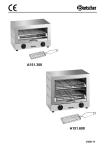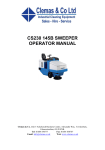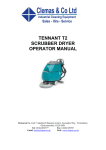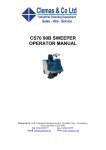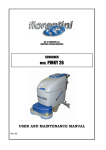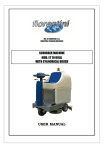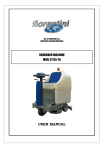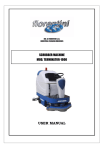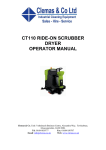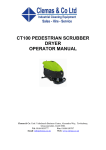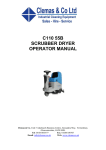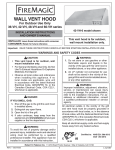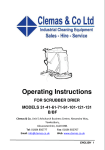Download Operator Manual
Transcript
CS220 140B SWEEPER OPERATOR MANUAL Clemas & Co. Unit 5 Ashchurch Business Centre, Alexandra Way, Tewkesbury, Gloucestershire, GL20 8NB. Tel: 01684 850777 Fax: 01684 850707 Email: [email protected] Web: www.clemas.co.uk Congratulations for your choice! FIORENTINI S.r.l. thanking you for the preference to our product, would like to remind you that FIORENTINI S.r.l production covers manufacture and marketing of industrial cleaning machines and is currently a leading company in this sector. Our tradition and competence guarantee technical quality of your choice; actually all our products are being built first quality materials through criteria that can give reliability, solidity and functionality satisfying every kind of customers. FIORENTINI has recently obtained the quality system certificate conforming to the requirements of UNI EN ISO 9001:2000. We wish therefore inviting you to contact us, unhesitatingly, for every kind of request, as technical or commercial; we’ll be pleased to be at your disposal for any information you may need. INDEX 1 2 3 4 5 6 GENERAL INFORMATION ....................................................................................................................................................................................4 1.1 SYMBOLS ..........................................................................................................................................................................................................4 1.2 PREMISES.........................................................................................................................................................................................................4 1.3 MANUAL CONSULTING...............................................................................................................................................................................5 1.4 WARRANTY ......................................................................................................................................................................................................5 1.4.1 WARRANTY OBJECT...............................................................................................................................................................................5 1.4.2 WARRANTY LIFE .....................................................................................................................................................................................5 1.4.3 WARRANTY APPLICATION ..................................................................................................................................................................6 1.4.4 RETURNED GOODS..................................................................................................................................................................................6 1.4.5 EXCEPTION................................................................................................................................................................................................6 1.5 CONFORMITY DECLARATION ..................................................................................................................................................................6 CARATTERISTICHE DELLA MACCHINA E DATI TECNICI .............................................................................................................8 2.1 IDENTIFICAZIONE......................................................................................................................................................................................8 2.2 MACHINE FEATURES AND TECHNICAL DATA...................................................................................................................................9 2.2.1 DESCRIPTION...........................................................................................................................................................................................9 2.2.2 DESCRIPTION AND FEATURES OF THE MAIN PARTS..............................................................................................................9 2.3 MAIN PARTS OF THE MACHINE............................................................................................................................................................ 10 2.3.1 DASHBOARD............................................................................................................................................................................................ 12 2.3.2 USE OF THE MACHINE........................................................................................................................................................................ 13 SAFETY............................................................................................................................................................................................................ 21 3.1 RIGHT USE OF THE MACHINE ............................................................................................................................................................... 21 3.2 WRONG USE OF THE MACHINE............................................................................................................................................................. 21 3.3 SUGGESTED EQUIPMENT ....................................................................................................................................................................... 22 3.4 OPERATOR’S QUALIFY ............................................................................................................................................................................. 22 3.5 PROTECTION AND WARNING DEVICES ............................................................................................................................................ 23 3.6 OTHER DANGERS........................................................................................................................................................................................ 24 3.7 SAFETY SIGNALS....................................................................................................................................................................................... 25 STARTING THE MACHINE ...................................................................................................................................................................... 27 4.1 TRANSPORT AND HANDLING................................................................................................................................................................ 27 4.2 STORAGE ....................................................................................................................................................................................................... 29 4.3 UNPACK THE MACHINE............................................................................................................................................................................ 29 4.4 STARTING THE MACHINE ...................................................................................................................................................................... 29 4.5 BATTERY INSTALLATION ...................................................................................................................................................................... 29 4.6 BATTERY CHARGER INSTALLATION .................................................................................................................................................. 29 4.7 USE THE MACHINE.................................................................................................................................................................................... 30 MAINTENANCE ............................................................................................................................................................................................ 31 5.1 PERIODICAL MAINTENANCE.................................................................................................................................................................. 31 5.2 BATTERIES MAINTENANCE .................................................................................................................................................................. 32 5.2.1 DENSITY MEASUREMENT ................................................................................................................................................................ 32 5.2.2 FILL UP THE WATER ........................................................................................................................................................................... 32 5.2.3 LIMIT OF CHARGE ............................................................................................................................................................................... 32 5.2.4 BATTERIES OUT OF SERVICING ................................................................................................................................................... 32 5.2.5 TECHNICAL DATA OF BATTERY CHARGER ................................................................................................................................. 33 5.2.6 ELIMINATION OF BATTERIES....................................................................................................................................................... 33 5.3 ELECTRIC SYSTEM CHECK UP ................................................................................................................................................................ 33 5.4 MAINTENANCE’S REGISTER.................................................................................................................................................................. 34 TECHNICAL SERVICE ................................................................................................................................................................................ 35 6.1 ADDRESSES FOR TECHNICAL SERVICE............................................................................................................................................. 35 6.2 CLAIM REPORT ............................................................................................................................................................................................ 36 GENERAL INFORMATION 1 S32B GENERAL INFORMATION 1.1 SYMBOLS This symbol is used to get the operator’s attention on procedures or precautions to be followed in order to avoid damages to users or to the support. This symbol is used to get the operator’s attention on general information. 1.2 PREMISE FIORENTINI S. r. l. is the only owner of this manual. The reproduction of all or part of the manual or the transmission to third parties with mechanic or electronic devices are forbidden without a written manufacturer’s authorization. This manual is supplied to the customers in one original copy when differently specified during the order. This manual is supplied to the customer with the machine and it must be kept with it even when the machine has to be transferred. Please, keep the manual in a safe place and for all the machine lifetime. Purchaser is responsible for showing the manual to qualified people. In case of loss ask for a duplicate to FIORENTINI Co.. FIORENTINI S.r.l. is not responsible for any kind of damages caused by people or things due to the nonobservance of the instructions of this manual. FIORENTINI reserves the right to add at any time and without notice all the technical and commercial changes considered useful for the customer. Therefore data and information in this manual can be updated. Revision 00 Maggio 2006 Page 4 di 37 GENERAL INFORMATION S32B DICHIARAZIONE CE DI CONFORMITA’ ING. O. FIORENTINI s.r.l. Loc. Rombola 50030 PIANCALDOLI (FI) ITALIA SISTEMA QUALITA’ AZIENDALE CERTIFICATO ISO9001 DICHIARIAMO SOTTO LA NOSTRA RESPONSABILITA’ CHE LA MACCHINA Marca FIORENTINI Tipo N° serie Anno di costruzione 2005 RISULTA IN CONFORMITA’ con quanto previsto dalle seguenti direttive e normative armonizzate comunitarie: DIRETTIVA COMUNITARIA DIRETTIVA MACCHINE 98/37/CE DIRETTIVA COMPATIBILITA’ ELETTROMAGNETICA 89/336/CE DIRETTIVA SULLA RESTRIZIONE DI SOSTANZA PERICOLOSE 2002/95/CE DIRETTIVA SULL’ESPOSIZIONE DEI LAVORATORI ALLE VIBRAZIONI 2002/44/CE Piancaldoli Luogo e data Revision 00 Maggio 2006 Ing. O. Fiorentini S.r.l. Il titolare Ing. O. Fiorentini Firma Page 7 di 37 TECHNICAL DATA 2 S32B MACHINES FEATURES AND TECHNICAL DATA 2.1 IDENTIFYING THE MACHINE A silver label is sticked on the protection case of the steering column and clearly shows the data referring to the “CE” marking. MADE IN ITALY S.N. S32B 100 36 Hz 890 A 80 kkW 5,3 Mod V Kg 2006 Ing. O.Fiorentini S.r.l. 50030 Piancaldoli (FI) PICTURE N° 1 The label has never to be removed. In case of damage it is necessary to ask for a copy. The scrubber cannot be sold without the label. Revision 00 Maggio 2006 Page 8 di 37 TECHNICAL DATA S32B 2.2 DESCRIPTION AND FEATURES OF THE MAIN PARTS 2.2.1 DESCRIPTION The sweeper – S32 - has been designed to clean flat and hard surfaces by means of a sweeping system and suction of the dust into a suitable tank. The traction system is based on oleodynamic engines fed by a pump which is driven by an endothermic petrol or GPL engine. The oleodynamic pump also feeds the engine of the central brush, the engine of the side brushes, the oleodynamic actuators for the lifting and sink of the waste tank. The vacuum and the filter shaker engines are fed by a battery supplied with the machine. The sweeper is equipped with a side rotating brush (the left side brush is optional) which has to bring dust into the central part of the machine. The main brush brings dust into the waste tank thanks to a suction system. The machine must be used on dry or damp surfaces and can be equipped with a water system which has to pull dust down. Thanks to the dashboard the operator can control all the machine functions and a series of LEDs shows to the operator the battery status or the errors detected by the electronic card. The operator can control all the main functions of the machine and in particular: ¾ ¾ ¾ ¾ ¾ ¾ start both the central and the side brushes; start the dust pull down device (optional); lift up or sink down of the waste dust; open or close the flap set up in the front side of the machine; start the vacuum engine; start the filter shaker. Important: before switching the machine off the operator must ¾ ¾ 2.2.2 sink the waste tank down; lift the brushes up to avoid damages to the brushes bristles and decrease their effectiveness. MAIN PARTS OF THE MACHINE ¾ Zinc-plated steel or stainless steel frame; ¾ ¾ ¾ ¾ ¾ ¾ ¾ ¾ RH rotating brush; LH rotating brush (optional); vacuum system to pick dust up; one drive wheel; two idle wheels; steering wheel assy; operator’s seat; dust pull down device (optional). FIORENTINI Co., taking the new CE safety rules into consideration, manufactures the machine following the CE directives about safety and health. The high quality material, the high technology and FIORENTINI experience guarantee the performance and the reliability of this machine . Each machine is tested during the manufacturing process and the final check is done before the machine is shipped out. Revision 00 Maggio 2006 Page 9 di 37 S32B TECHNICAL DATA 2.3 TECHNICAL DATA FEATURES 1815 x 1010 x 1400 mm LENGTH x WIDTH x HEIGHT 1 CENTRAL + 1 o 2 SIDE N° BRUSHES HYDRAULIC TRACTION Ø330 x 800mm CENTRAL BRUSH DIMENSION SIDE BRUSHES DIMENSION Ø500 mm SWEEPING WIDTH 1050 mm SWEEPING WIDTH WITH LEFT SIDE BRUSH 1300 mm 400 - 6 mm WHEEL DIAMETER 6 m² FILTERING SURFACE WASTE TANK 180 litri WEIGHT WITHOUT BATTERIES 535 Kg ENGINE BRUSHES HYDRAULIC ENGINE TRACTION HYDRAULIC ENGINE VARIABLE DELIVERY PUMP FIXED DELIVERY PUMP VACUUM MOTORS FUNCTIONS MAN ON BOARD DRIVE U-TURN LANE MANUAL CENTRAL BRUSH LIFTING UP SYSTEM HYDRAULIC SIDE BRUSH LIFTING UP SYSTEM SERVICE BRAKE MECHANICAL PARKING BRAKE MECHANICAL WITH A LEVER PERFORMANCES FORWARD SPEED 0 – 6 Km/h REVERSE SPEED 0 – 6 Km/h 10% MAX SLOPE 5% a 3 Km/h MAX SLOPE FOR U-TURN 8450 m²/h WORKING CAPACITY UP TO m² /h ECOLOGICAL FEATURES NOISE AT OPERATOR’S EAR VIBRATIONS AT OPERATOR’S SEAT Revision 00 Maggio 2006 < 80 DECIBEL < 2.5 m/s² Page 10 di 37 S32B TECHNICAL DATA The technical data listed above may be changed by the manufacturer without notice. In any case, FIORENTINI is available for any further information or explanation. MEASUREMENT UNITS CONVERSION Length 1 inch = 1” = 25,4 mm Temperature T (K) = t (°C) + 273 / t (°F) = 1,8 t (°C) + 32 Revision 00 Maggio 2006 Power 1 kW = 1,36 CV = 1,34 BHP Pressure 1 bar =100 kPa = 14,5 psi Page 11 di 37 S32B TECHNICAL DATA 2.3.1 THE DASHBOARD The dashboard is composed by a series of switches that activate or deactivate all the functions of the machine. The function of every switch is shown by a pictogram. Picture nr. 2 shows the dashboard. The function of every switch and pilot light is explained in the scheme below. 4 3 6 7 2 1 5 PICTURE N° 2 1 2 3 4 5 6 7 Key switch Hour counter Horn button Lights switch Filter shaker switch Suction engine switch Vacuum engine pilot light Revision 00 Maggio 2006 Page 12 di 37 TECHNICAL DATA 2.3.2 S32B USE OF THE MACHINE Starting the machine. Insert the key into the dashboard and turn it once clockwise. Wait until the pilot light shows the battery level. Before using the sweeper please check the hydraulic oil level in the tank of the hydraulic system. The oil level must be kept between the two notches of the level indicator inside the engine bonnet (see picture 3). If the oil level is not sufficient, fill it up. Before this operation, switch the machine off and remove the key from the dashboard. PICTURE N° 3 Oil tank cap Revision 00 Maggio 2006 Page 13 di 37 S32B TECHNICAL DATA Picture 4 Moving the machine. Forward speed Reverse speed By means of the forward/reverse pedal the operator can move the machine. The operator has to put the foot onto the pedal and press it with the heel to move forward or with the top of the foot to move the machine backward. Service brake Forward/reverse pedal Stopping the machine. Picture 5 The sweeper is equipeed with one parking brake and one service brake. The last one (see picture 5) is controlled by a pedal placed next to the forward/reverse pedal. The parking brake is controlled by a knob (see picture 7). The operator Revision 00 Maggio 2006 Page 14 di 37 S32B TECHNICAL DATA has to pull this knob when the sweeper is not working. By means of the black little lever under the knob the operator can release the brake. Parking brake knob Picture 7 Important: the brake must be checked and registered every three months. Driving seat regulation. By means of the lever under the driving seat (see picture 8) the operator can regulate the horizontal position of the seat itself. Regulation lever Picture 8 Revision 00 Maggio 2006 Page 15 di 37 S32B TECHNICAL DATA How to use the machine. The operator can start the three functions of the machine by means of the three levers next to the driving seat. Make reference to the scheme below for the explanation of the yellow sticker under the levers (see picture 9). Picture 9 Pressure lever main brush The operator has to pull the lever down in order to sink down and start the rotation of the central and side brushes. Pulling the lever up the hydraulic engines of the brushes stop and the brushes return in their original position. The operator has to pull the lever up in order to sink the waste tank down. Pulling the lever down the tank returns in its original position. The operator has to pull the lever up to open the flap and pick the dust up into the waste tank. Pulling the lever down the flap closes. Moving the lever towards the operator and hooking it, the main brush lifts up. Moving the lever higher, the main brush goes down. Revision 00 Maggio 2006 Page 16 di 37 TECHNICAL DATA S32B The operator has to follow the rules below to sweep the surface: ¾ ¾ ¾ ¾ start and sink the sweeping group down; start the vacuum engine; open the flap; drive the sweeper at the same speed to clean all the surface. The operator has to follow the rules below to empty the waste tank: ¾ ¾ ¾ ¾ ¾ close the flap; start the filter shaker to clean the vacuum filter; lift the waste tank up; open the flap, let the dust fall down from the waste tank and start the filter shaker again to clean the vacuum filter ; keep away from the waste tank and make sure that nobody is near the sweeper. Sink the waste tank down. Main brush replacement The operator has to follow the rules below to replace the main brush: ¾ by means of the lever (see picture n. 10) open the little door on the right side of the sweeper; ¾ unscrew the bolts (see detail 1 in picture 10) that hold the rubber catch sheet; ¾ remove the sheet; ¾ remove the dust cover rubber; ¾ unloose the knob and open the door that holds the brush (picture 11); ¾ remove the brush (picture 12); ¾ set a new brush up and check its holders; ¾ follow now the opposite operations. Detail 1 Dust cover rubber Revision 00 Maggio 2006 Picture 10 Page 17 di 37 S32B TECHNICAL DATA Knob Brush support Picture 11 Picture 12 Brush holder detail Revision 00 Maggio 2006 Page 18 di 37 SAFETY S32B Side brush replacement ¾ ¾ Unscrew the bolts (picture 13) and remove the brush; replace the brush and tighten the bolts again. Picture 13 How to replace the vacuum filter of the sweeping group and filter shaker engine ¾ Important: remove the key from the dashboard of the sweeper; ¾ open the bonnet of the machine by means of the button (picture 14); ¾ lift the waste tank cover up; ¾ unloose both screws that hold the filter (picture 15); ¾ remove the filter shaker support; ¾ disconnect the connectors of the shaker filter engine; ¾ lift up and replace the damaged or clogged filter; ¾ follow now the opposite operations. Bonnet button Picture 14 Revision 00 Maggio 2006 Page 19 di 37 SAFETY S32B Fastening screws Picture 15 Thanks to the vibrations of the filter shaker engine, the dust falls down from the filters into the waste tank. If it is necessary, remove and replace the filter shaker engine. How to clean the waste tank The operator has to follow the instructions below to clean the waste tank: ¾ ¾ ¾ ¾ ¾ lift the waste tank up and open the flap; fasten the waste tank by means of the red safety lever (picture 16); clean the waste tank; place the red safety lever in its original position; sink the waste tank down. Picture 16 Revision 00 Maggio 2006 Page 20 di 37 S32B SAFETY 3 SAFETY 3.1 RIGHT USE OF THE MACHINE This sweeper is equipped with an internal combustion engine and has been designed to clean open spaces. S32 can pick up dust from horizontal surfaces or with a slope not higher than 10% at a speed not higher than 3km/h. During a Uturn, the slope has not to be higher than 5%. 3.2 WRONG USE OF THE MACHINE The manufacturer is not responsible for damages due to a wrong use of the machine as stated in the scheme below. ¾ ¾ ¾ ¾ ¾ ¾ ¾ ¾ ¾ ¾ ¾ ¾ ¾ The machine cannot be driven by non-authorized personnel; The machine cannot sweep sloping surfaces whose gradient is higher than 10% or surfaces with holes; During a U-turn on a 5% sloping surface the machine has to be driven at a speed not higher than 3 km/h; The machine cannot be used in places with dangerous substances and in particular with explosive atmospheres or with a bad microclimate; The machine cannot clean surfaces with inflammable products; The machine cannot be used as a means of transport for people or other means of transport; The machine protection devices cannot be modified or tampered; Batteries must be recharged in a fanned room; The operator have always to respect safety rules; The operator cannot use equipments or devices that can create problems to the machine working; The machine components cannot be modified without FIORENTINI’s authorization; The operator cannot use acids that can damage the machine; The operator has always to respect the rules written in the user manual. Please read carefully and do not cover the labels sticked on the machine. FIORENTINI S.r.l. is not responsible for a wrong use of the machine. Important. In case of fire use a dust extinguisher. Do not use water. Revision 00 Maggio 2006 Page 21 di 37 S32B SAFETY 3.3 SUGGESTED EQUIPMENTS In order to use the machine in a proper way, we suggest to use FIORENTINI equipments and original spare parts. FIORENTINI S.r.l. Technical Dept. is always at your disposal to design components or parts for a particular use of machine as requested by the customer. 3.4 OPERATOR’S QUALIFY OPERATION OPERATOR’S QUALIFY Driving/control of the machine Trained operator Installation/ disinstallation Fiorentini technician Mechanical parts maintenance Mechanic/trained technician Electrical parts maintenance Electrician/ trained technician Hydraulic system maintenance Mechanic/ trained technician Cleaning of the machine Unskilled worker Dismantling and demolition Unskilled worker FIORENTINI S.r.l. suggest to train the operator before using the machine. The operator must be trained about safety rules and carefully read this manual. FIORENTINI S.r.l. is not responsible for any possible damage to people and/or things caused by the non-observance of the instructions dealt within this manual. Revision 00 Maggio 2006 Page 22 di 37 SAFETY S32B 3.5 PROTECTION AND WARNING DEVICES Side brush case Warning device The machine is equipped with a nylon central brush that rotates while the machine is on duty. The machine cannot reach dangerous areas thanks to a stainless steel case set up on the brush. The operator can remove the brush case only with special tools. S34 sweeper is equipped with three warning devices that have to prevent dangers if somebody is near the machine during the cleaning. ¾ ¾ ¾ an acoustic warning device during the normal use of the machine; a warning acoustic and intermittent device while the operator is reversing; a yellow flashing light to signal that the machine is functioning. It is absolutely forbidden to camper, remove or disactivate these devices durino the normal use of the machine. Please check their effectiveness regularly (read the chapter about maintenance). Revision 00 Maggio 2006 Page 23 di 37 SAFETY S32B 3.6 OTHER DANGERS Starting from the design of the machine, FIORENTINI studies every kind of danger that can occur whilst using the sweeper in order to prevent or at least reduce the number of accidents for the operator. The operator can avoid many risks that can occur during the machine operating thanks to a series of signals on the machine. SQUASHING This kind of danger can occur: • • • whilst regulating the central brush; whilst cleaning the box during the batteries’ installation or during the hydraulic oil’s check. Whilst regulating the central brush, the ignition key must be kept away from the dashboard in order to avoid the casual starting of the machine. TURNOVER This kind of ranger can occur: • during the normal use of the machine when sloping limits are not respected - as specified in the manual – or whilst cleaning disconnected surfaces or surfaces with holes and high depressions (photo 3.2) Do not use the machine to wash sloping surfaces higher than 12% or surfaces with holes or depressions which might compromise the stability of the machine. FIORENTINI is not responsible for accidents occurred to people or things provoked by a wrong use of the machine, i.e. using the machine on surfaces which can compromise its stability. The purchaser must stick proper labels on the machine to show the operator the right use of the sweeper. Revision 00 Maggio 2006 Page 24 di 37 SAFETY S32B 3.7 SAFETY SIGNALS On the brushes protection cases of the machine the operator can find stickers that show different dangers that can occur whilst operating with the sweeper. Dangers’ signals are triangular with black pictures on a yellow background DANGERS Prohibitions’ signals are round with black pictures and a red stripe PROHIBITIONS What is it ? This signal forbids to remove the protection of pieces in movement. What to do During the installation or the maintenance make sure that the ignition key is not in the dashboard before removing the mobile protections. While the machine is operating make sure that all covers are well fixed. Picture 17 Revision 00 Maggio 2006 Page 25 di 37 S32B SAFETY What is it ? Squashing ranger: this can of ranger can occur when the engine cover is open. What to do Whilst installing or maintaining the engine, the operator has to stop the engine cover with its rod. Picture 18 The purchaser must replace danger signals on the machine if they are deteriorated. It is absolutely forbidden to remove or temper danger signals. What is it ? This signal shows fire ranger due to inflammable liquids. What to do Whilst filling the tank with petrol, the operator has to use a suitable funnel to avoid to dirt the machine. Moreover, this operation has to be done in a proper place where no primer danger can occur. Picture 19 Revision 00 Maggio 2006 Page 26 di 37 HOW TO START AND USE THE MACHINE 4 S32B HOW TO START AND USE THE MACHINE 4.1 TRANSPORT AND HANDLING The machine is delivered to the purchaser in a proper package (see picture 20 below). A black arrow on the package shows the barycentre. This arrow must be in the middle of the elevator or transpallet forks. The package must be carefully handled. Do not place one package on another one. If agreed with the purchaser, the machine can be delivered without package, placed on a pallet and fixed by means of straps. The purchaser must make sure that the machine has not been damaged during the transport and that all papers are on the machine. Otherwise, the purchaser must immediately contact FIORENTINI in order to sort out the problem. The purchaser is responsible for the transport of the machine if not differently agreed with FIORENTINI. Picture 20 Revision 00 Maggio 2006 Page 27 di 37 HOW TO START AND USE THE MACHINE S32B The machine must be handled with proper devices as stated in the scheme below. Please, make sure that the black arrow on the package is always in the middle of the elevator forks or the sling bands. Anchorage and/or sling points are set on the machine up in order to keep the stability of the sweeper during the handling. PACKAGE HANDLING EQUIPMENT PICTURE Paperboard or plywood box on a pallet Fork elevator N° 17 None Fork elevator or crane truck with a two-band-sling and equalizer N° 18 LOADING SYSTEM Picture 21 Picture 22 Make reference to § 2.3. for the dimensions and the weight of the machine. Trained personnel only can handle the machine. The bands used to lift the machine up must have the same loading capacity as the machine load. Handling operations must be done without causing a loss of stability of the machine. Otherwise, the machine can be damaged or the operator can de in danger. Revision 00 Maggio 2006 Page 28 di 37 MAINTENANCE 4.2 S32B STORAGE The machine must be stored in a closed and dry place if not immediately installed in order to keep every part safe. Relative humidity must be lower than 80% and the storage temperature must be between 3°C ≤ t ≤ + 45 °C. 4.3 ¾ ¾ ¾ ¾ ¾ 4.4 ¾ ¾ 4.5 INSTRUCTIONS TO UNPACK THE MACHINE Cut off the bands being careful of the elastic reversion Take away on the base of the cartoon the clips that keep it together with the pallet. Where plywood is take away the clips at both sides and at the base of each panel. Cut off the clips that stop the machine. Put the machine at ground level. HANDLE THE UNPACKED MACHINE Check the machine and mount the batteries if not installed. To displace it, after use, take off the battery cables, the brushes and the squeegee; to deplace it through a longer space pack the machine once again in its own package. BATTERIES INSTALLATION To install the batteries follow the instructions as below : ¾ ¾ ¾ ¾ ¾ Raise up the battery-cover chain guard; install the batteries in the suitable slot being sure that no breakings are in the battery cases; never add distilled water after charging the batteries; clean up the surfaces needing to be connected ; Battery handling is made easier by handles on both sides. 4.6 CHARGER INSTALLATION The battery charging must be done, as previously reminded, predisposing a suitable suction system of gases coming out during charging. Alternatively it must be done in a dry and airy place, far from heat sources and corrosive environments. Protect the electrical system with a delayed switch or with a more capacity fuse than the charger. Follow the polarity instructions for the battery inlet. Revision 00 Maggio 2006 Page 29 di 37 S32B MAINTENANCE 4.7 STARTING THE MACHINE S32 sweeper can be starter only after a complete check up of all its components and safety devices. This is why, well trained FIORENTINI technicians do a strict control while manufacturing the machine and an accurate final test. Anyway, FIORENTINI suggests to do another test before starting the machine. Please see the scheme below. Test Esito Posit. Negat. Hydraulic oil level Engine oil level Engine cooling water level Wheels brake functioning Pilot lights functioning If the result of the test is positive, the machine can be started. On the contrary, please contact immediately FIORENTINI service. The test above must be periodically carried out in order to keep the machine always efficient. Revision 00 Maggio 2006 Page 30 di 37 S32B MAINTENANCE 5 MAINTENANCE 5.1 PERIODICAL MAINTENANCE A periodical maintenance is important in order to keep the machine efficient. Please fill in the format below all the interventions done on the machine. If the original product is not conform, do not use it and wait for the repair or replacement of the defected part. Maintenance must be carried out by trained personnel only especially for the electrical or electromechanical systems. Technicians must use suitable tools for every kind of intervention. Make reference to FIORENTINI SERVICE only for original spare parts (§ 7.1. / 7.2.). OPERATION INTERVENTION HOW OFTEN Clean the waste tank and the oil filter of the suction motor • Cleaning • ¾ Controls Do not use corrosive substances. Do not use bolts of water. Check the oil level of the hydraulic system Daily Every week Check and regulate the braking system Every 3 months Check if the battery cables are well fixed Every 6 months ¾ ¾ Check the safety devices Check the electric system ¾ Complete overhaul Revision 00 Maggio 2006 Every year Every 5 years Page 31 di 37 MAINTENANCE S32B 5.2 BATTERY MAINTENANCE Control of battery charge can be easily made when the operator is working with the machine through the indicator placed on the control bridge. It shows the following information : ¾ On green : the battery is charged ¾ On yellow : the battery is half-charged ¾ On red : the battery is flat During charging don’t let the battery box opened ¾ Don’t use fire and no smoke nearby the batteries ¾ Take care to the liquid because corrosive ¾ Don’t sparkle close to the batteries ¾ Battery gas is explosive ¾ Never invert the polarity 5.2.1 DENSITY MEASUREMENT Hydrometry can be made with batteries under charge with a densimeter. Do as it follows : ¾ ¾ ¾ 5.2.2 Put the gun densimeter and take a quantity of electrolyte sufficient to push up the floating; Keep care the top of it doesn’t touch the rubber or the glass walls. For a measure of density, after filling up with distilled water, density has to be uniform in the box. WATER FILLING UP ¾ ¾ 5.2.3 Put distilled water in each cell of the battery before charging the batteries to take the liquid at 6 mm over the plates. This operation has to be made every time the level goes down, but never over a week between two filling up. CHARGING LIMITS It’s not necessary to charge the battery if density, after a working day, is underneath 1,24 (28 Bè). The best recommended temperature is 45°C. If the electrolyte temperature goes up of 10/12°C inside facing to room temperature, it can be overcharged without depending from the normal use. 5.2.4 OFF DUTY OR INACTIVE BATTERIES While inactive, the batteries can go flat by themselves. If battery is not frequently used, it may occurs to do the following operations: ¾ ¾ Once in a month place it under charge, to a voltage indicated as “final”, until all elements are full of gas and is possible to read tension and specific weight for 3-4 hours about ; It’s necessary to do it even when measurements of specific weight show high values. If battery stays inactive longer it has to be preserved in a dry place. Revision 00 Maggio 2006 Page 32 di 37 MAINTENANCE 5.2.5 S32B TECHNICAL FEATURES OF THE CHARGER The charger has the following features: o o Entrance Exit Directive: Electromagnetic compatibility 89/336/CEE - (EN 50081 – EN 50082) and next modification 92/31/CEE Low tension 73/23/CEE – (EN 60950 class 1) and next modification 93/68/CEE N.B. For that it concerns other problems on the batteries, please consult the user manual enclosed with the battery charger. 5.2.6 BATTERIES DISPOSAL Exhausted batteries are considered toxically waste. They have to be disposed in storages under specific authorization. In case of necessity, a “ temporary storage” can be effected, by laws in force, mainly : ¾ ¾ Having a special authorization for it ; Placing them in plastic boxes with higher capacity than the volume of the battery electrolyte, or anyhow without possible water infiltrations. 5.3 CHECKING THE ELECTRIC SYSTEM It is very important to check the electric system up every two years. Disconnected cables or burnt cables must be immediately replaced. Interventions on the electric system must be carried out by a trained technician. Every kind of intervention not explained in the operator manual must be carried out by FIORENTINIs technicians. Revision 00 Maggio 2006 Page 33 di 37
































